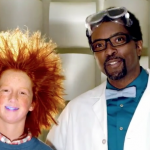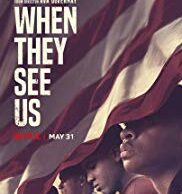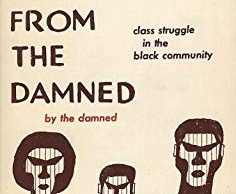Beyond Starship Enterprise: Racism, Sexism, and the Science Pipeline
Decked out in a white lab coat straight from central casting, the African American science teacher featured in Target’s latest “Back to School” commercial is a cartoonish reminder of the dearth of images of black scientists in American popular culture. Riffing about school supplies to the tune of Thomas Dolby’s “She Blinded Me with Science,” the teacher declares, “Parents, this year I’m going to teach your kids that magic does exist. It’s called science,” as he makes the rounds in a magical classroom filled with mostly white students. When youth of color see scientists in mainstream film, TV, or advertising, it’s usually the lone wolf, trailblazing, bullet proof-Einstein, white male (or the sexualized white female variant, typically buried behind thick attitude glasses ready to be whipped off before a sex scene) peering through a microscope with furrowed brow. Mainstream representation codes heroism, scientific discovery, scientific genius, and rationality as white. Recent media coverage of the Mars Curiosity rover’s ecstatic, predominantly white, Jet Propulsion Lab (JPL) crew was yet another affirmation of this link.
As an aspiring oncologist enrolled at a South Los Angeles high school not far from JPL, college-bound twelfth grader Karly Jeter’s role model is African American surgeon Ben Carson. He is the only person of color in the medical science field that she looks up to. She says that this is partly because he “made it on his own” and partly because she doesn’t know of any other examples. Karly’s desire to be an oncologist stems from being a cancer survivor herself. She describes finding a cure for cancer as her biggest passion. On the other end of the college spectrum, planetary geologist Devin Waller has a Bachelor’s in Astrophysics from UCLA and a Master’s in Geoscience from Arizona State University. As a graduate student her concentration was in planetary remote sensing on Mars. At ASU, she was also a research analyst for projects involving the predecessors to Curiosity. Although they are at two different stages in the science education pipeline, these young women both represent the challenges that confront African American women in science and technology.
In her book Swimming Against the Tide: African American Girls and Science Education, Sandra Hanson explodes the myth that black girls are somehow disinterested in science due to hyper-religiosity or “culture.” Hanson found that, despite significant institutional and societal barriers, there is greater interest in science among African American girls than in other student populations. She frames this seeming paradox in historical context, stressing that “Early ideologies about natural inequalities by race influenced the work of scientists and scholars as well as the treatment of minorities in the science domain. Racism is a key feature of science in the United States and elsewhere. This has a large impact on the potential for success among minority students. Early work on science as fair has not been supported.”
Hanson outlines some of the obstacles that confront budding African American women scientists from elementary school to the postgraduate level. Stereotypes about girls of color lacking proficiency in science, the absence of nurturing mentors, the dearth of education about people of color who have contributed to science research (i.e., culturally responsive science instruction), and academic isolation often deter youth who would like to pursue science careers. Science researcher Diann Jordan, author of Sisters in Science, notes that her study of black women scientists helped her combat the sense of isolation she felt in a field where she was often perceived as an interloper. Nonetheless, Jordan, Hanson, and other researchers have found that “African American girls in particular are very positive about science.” Stem cell scientist Valerie Johnson McCullar stresses that black girls begin with high interest in math and science in elementary school then begin to lose interest in quantitative subjects because “if there is not someone around you to constantly show you the beauty in certain things you get channeled in certain ways.” Hanson notes that black girls, as opposed to white girls, are actually more inclined to stay engaged with science throughout their K-12 careers. In elementary and middle school girls tend to outperform males in math and science. However the “trend tends to reverse itself in the white but not the African American communities as the young people enter high school.” Indeed, “African American girls have been found…to be in more advanced math classes, to get better science grades, and to participate more in science than their male counterparts.” But Hanson emphasizes that greater participation amongst African American girls does not necessarily translate into high achievement. Academic outcomes for students of color still lag behind their white counterparts. Indeed, the presumption of underachievement that dogs even the “best and brightest” science students underscores the depth of educational apartheid in the U.S.
Karly Jeter’s desire to be an oncologist developed in spite of the culture of her school. Similar to the magical Target classroom Karly is typically only one of two or three black students in her Advanced Placement classes. Reflecting back on her junior year, she bitterly recounted when her AP English teacher excluded her from a list of students (all Asian and Latino) he predicted would pass the mock AP exam. When she was one of the few who passed he accused her of cheating. In her chemistry class she and other African American students were routinely criticized by their black teacher as having no other ambition in life besides playing sports.
Although there have been small gains, the abysmal number of African American students who successfully pursue college degrees and careers in science is a national disgrace. From K-12 to college, African American youth who are passionate about science education often face an uphill battle. President Obama’s recently announced Master Teacher STEM initiative is ostensibly designed to address these disparities. It would develop a core of fifty educators to assume leadership in instruction, training, curriculum development, and mentorship in their school communities. Though the unveiling of the new plan provided a nice photo-op, Obama’s vision doesn’t address the culture of institutional racism that defines under-resourced schools. As Hanson argues, “research on African American women’s experiences in the science education system shows the critical role of teachers. Unfortunately, African American women are often marginalized because of their race and gender. Science teachers tend to overlook these young women as a source of science talent…Textbooks and teachers focus mainly on science knowledge and inventions created by white scientists. Hence (students) are seldom made aware of the contributions of African Americans (much less African American women) in science.”
Karly’s experiences illustrate how the nexus of low expectations, as well as college preparation and course programming hurdles can combine to derail the most motivated science students. She describes battling with her school counselor to be programmed into the elite AP Biology and Physics courses that have become virtual gatekeepers for future college science majors. She remarks that “some counselors believe that you might not succeed. They say maybe it might be a little too hard for you.” In many instances parental intervention is mandatory for black science students at every step of the way. Although conventional wisdom holds that class status and income dictate interest and academic success in science, Hanson concluded that social capital by way of family support and investment in the community were the most compelling factors. Girls whose parents (regardless of income levels, education and family composition) were supportive and engaged in their educations were more likely to pursue science. In addition, girls who had higher levels of community involvement, volunteerism and participation in religious activities were also more likely to pursue a science major and have high achievement in science.
The absence of quality college prep instruction at the high school level is often one of the most significant roadblocks to college access. Initiatives like the Latino and African American High School Internship Program for students in South and East Los Angeles highlight how low expectations can deter youth of color from careers in science and technology. Based at Children’s Hospital Los Angeles the program recruits high school seniors from “underrepresented” schools. According to an article in the L.A. Times the program has struggled to attract African Americans because:
Some area schools are not receptive and fail to see the potential in their students [the program’s founder said]. ‘I get responses like, ‘You know, the type of students you’re looking for, we just don’t have…That is just not right.’ Chuck Uzoegwu, 19, participated in the program in 2010 and is now studying business and is pre-med at USC. He first noticed a slow attrition of fellow African American classmates when attending King Drew Medical Magnet High School. In the summer program, he was one of only a few African American students. He returned to the hospital this summer to volunteer in the lab and said he has yet to meet a role model there who looks like him. ‘It disturbs me. It’s nice to come into a place and see other people that are like you,’ he said. ‘It definitely feels like the higher up you go in education, the higher up you go in any organization, the less African American males you see.
Uzoegwu’s experiences reflect the hard reality of many high schools where the number of African American students who are encouraged to pursue science is criminally low. At the elite level of enrollment in Physics and Advanced Placement (AP) science courses the numbers thin out even more. Nationwide, African American students are underrepresented in AP course enrollment and exam taking. At 14% of the U.S. student population they comprise only 3% of those enrolled in AP courses or taking AP exams. Native American students are also underrepresented. With the exception of a few states like Hawaii and South Dakota, there has been greater success in closing the AP gap for Latino students than Black or Native American students. In addition, some schools don’t even have AP courses, placing students who want to go to college at a significant disadvantage. According to the Harvard Education Press, “students who took AP math or science exams were more likely than non-AP students to earn degrees in particular physical science, engineering and life science disciplines.” Jacqueline Hernandez, a Watts resident enrolled in the Children’s Hospital internship program, decries the lack of AP classes at her school. Hernandez once feared her college dreams would be derailed by teenage pregnancy like those of her three sisters. In 1999 students from the Inglewood Unified School District in Los Angeles successfully sued to get more AP courses at their schools. The suit charged that Black and Latino students were systematically denied access to college preparation courses that were standard fare at white schools in Los Angeles County.
When AP courses are provided in so-called inner city schools, part of the enrollment gap comes down to inveterately low expectations for African American students. Most national studies on student performance confirm that teacher quality is perhaps the single greatest factor in student achievement and that teacher expectations are of paramount importance. In her book Culturally Relevant Teaching educator Geneva Gay argues that “positive and negative teacher attitudes and expectations have profound effects on student achievement.” Often African American students are perceived as defiant, unwilling to learn, criminals in training, saddled with dysfunctional family and cultural backgrounds that make them “bad” candidates for accelerated, gifted or college prep classes. According to the College Board report, “The vast majority of Black high school graduates from the Class of 2011 who could have done well in an AP course never enrolled in one because they were either ‘left out’ or went to a school that didn’t offer the college prep courses.” “Left out” is a euphemism for being viewed as underachieving, a theme that is consistent with my experience as a student in L.A. Unified during the late ‘80s. In my senior year I was one of a small handful of black students in AP English and AP Biology classes. There were few black males in these classes. The ones that were enrolled were frequently marginalized, targeted for goofing off and bounced out of class (while the white students who engaged in similar behavior got warnings). As the most disproportionately suspended, expelled and special education assigned group in the nation black males have targets on their backs. Numerous studies have shown that high rates of suspension and expulsion often lead to drop-out and incarceration. In this regime youth like Jarmaine Ollivierre have already been criminalized as expendable. In the 1990s, Ollivierre, a NASA aerospace engineer and former special education student from Philadelphia, participated in a tailored college preparation program that was designed to redress the 26% college-going rate at his high school. He went on to receive degrees in physics and aeronautical engineering. Unlike most special ed youth he had the benefit of strong mentors who saw his promise and provided him with resources and reinforcement.
While rigorous yet nurturing teacher-mentors of any kind are pivotal, the small number of African American science instructors is another factor in the marginalization of black science students. Unless Karly Jeter goes to a historically black college or university she will have few African American science professors as mentors. According to the National Science Foundation, “Black faculty with SEH (Science, Engineering and Health) doctorates differ from most other racial/ethnic groups in that a lower percentage were employed in RUVH (Research Universities with Very High research activity) institutions and a higher percentage were employed in master’s-granting institutions.” In 2008, African Americans who’d received Science and Engineering doctorates were only 4% of the faculty at U.S. colleges and universities. At Cal Tech, one of the leading science and technology institutions in the country, African Americans are less than 1% of the faculty. They are 4% of the faculty at MIT. In her report “Barriers for Black Scientists” chemistry professor Donna Nelson found that, “Blacks represented 8.8 percent of chemistry B.S. recipients in 2004 and 1.3 percent of all chemistry professors at the FY2005 “top 50” chemistry departments. The ratio 8.8 percent to 1.3 percent—versus a corresponding ratio of 37.7 percent to 77.5 percent for white males—indicates that black chemistry majors do not enjoy the supply of same-race faculty role models and mentors that majority chemistry majors do.”
Conservatives who disdain “liberal multiculturalism” in higher education dismiss such concerns about diversity in hiring as handwringing. According to this view there is only one standard academia should use; objective and unbiased, untainted by affirmative action. Yet white students are beneficiaries of cradle to grave affirmative action. White students grow up seeing the dominant image of rational, trailblazing scientific discovery (from films like Dr. Strangelove to 2001: A Space Odyssey to Close Encounters to The Right Stuff, etc.) as spearheaded by courageous rugged individualist white males. They are socialized to believe in a template of “purely” meritocratic success and individual achievement. Meritocracy becomes gospel and lucre. They can take it to the bank and use it to repel the less qualified savages. Racial or gender others who make it into science’s inner sanctum are either interlopers scrounging for handouts or shining exceptions bootstrapping up from the inner city wilds. At the insular level of college Physics and Engineering white male dominance is perpetuated by “boy’s club” peer groups, networks, faculty and administrative support systems that facilitate access for the racial majority. While she was at UCLA Devin Waller was the only African American woman in the Astrophysics department. On the first day of her upper division classes she recalls being asked by male students befuddled by her presence whether or not they “were in the right class.” Since peer networking and study groups in some science departments are largely white and male, white academic success and scholarly legitimacy in science become a self-fulfilling prophecy. For black women in white male dominated professions, showing vulnerability and having any kind of public failure are simply not options. Like many women of color Devin’s approach was that “You kind of go in there and set a precedent. Everything you do is watched. You have to establish yourself as intelligent. There were no black women in my classes. No one who looked like me.”
Not having anyone who looks like them as a faculty member, administrator and/or mentor influences the sense of isolation, anxiety, and burnout that students of color often experience in science disciplines. As an Electrical Engineering major Kimberly Bryant, founder of Black Girls Code, a nonprofit dedicated to developing African American girls as computer programmers, also found herself “feeling culturally isolated” during college. On her website she argues that the “dearth of African-American women in science, technology, engineering and math professions…cannot be explained by, say, a lack of interest in these fields. Lack of access and lack of exposure to STEM topics are the likelier culprits.”
In her autobiography Find Where the Wind Goes: Moments from My Life, Mae Carol Jemison (the first black woman astronaut and first woman of color in space) reflects on how, after professing interest in being a scientist to one of her teachers, she was told to set her sights on being a nurse instead. As a sixteen year old undergraduate at Stanford University, Jemison was practically shunned by her physical science instructors. Although her experiences occurred during the sixties and seventies, the dominant view of who is a proper scientist has not changed and nursing is still a more acceptable aspiration for black women who are culturally expected to be self-sacrificing caregivers for everyone in the universe.
Ironically, a major inspiration for Jemison was Nichelle Nichols’ character Uhura from Star Trek, the first black woman astronaut ever portrayed on TV. Decades later, Jemison’s experiences are still being played out in science classrooms across the so-called post-racial U.S., where the contributions, struggles, and visions of scientists of color continue to be as “exotic” as the Starship Enterprise.
Sikivu Hutchinson is the author of Moral Combat: Black Atheists, Gender Politics and the Values Wars and the forthcoming Godless Americana: Race and Religious Rebels.






8 Comments